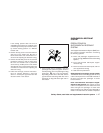The driver supplemental front-impact air bag is
located in the center of the steering wheel. The
passenger supplemental front-impact air bag is
mounted in the dashboard above the glove box.
The supplemental front air bags are designed to
inflate in higher severity frontal collisions, al-
though they may inflate if the forces in another
type of collision are similar to those of a higher
severity frontal impact. They may not inflate in
certain frontal collisions. Vehicle damage (or lack
of it) is not always an indication of proper front air
bag system operation.
The NISSAN Advanced Air Bag System hasdual
stage inflators. It also monitors information from
the crash zone sensor, the Air Bag Control Unit
(ACU), seat belt buckle sensors, occupant clas-
sification sensor(pressure sensor) andright front
passenger seat belt tension sensor. Inflator op-
eration is based on the severity of a collision and
seat belt usage for the driver. For the right front
passenger, it additionally monitors the weight of
an occupant or object on the seat and seat belt
tension. Based on information from the sensors,
only one front air bag may inflate in a crash,
depending on the crash severity and whether the
front occupants are belted or unbelted. Addition-
ally, the right front passenger air bag may be
automaticallyturned OFFunder someconditions,
depending on the weight detected on the pas-
senger seat and how the seat belt is used. If the
front passenger air bag isOFF, the passenger air
bag status light will be illuminated (if the seat is
unoccupied, the light will not be illuminated, but
the air bag will be off). See “Front passenger air
bag and status light” later in this section for
further details.Onefront airbag inflatingdoes not
indicate improper performance of the system.
If you have any questions about your air bag
system, please contact NISSAN or your NISSAN
dealer. If you are considering modification of your
vehicle due to a disability, you may also contact
NISSAN. Contact information is contained in the
beginning of this Owner’s Manual.
When a front air bag inflates, a fairly loud noise
may be heard, followed by the release of smoke.
This smoke is notharmful and does not indicate a
fire.Care shouldbe takento notinhaleit, asit may
cause irritation and choking. Those with a history
of a breathing condition should get fresh air
promptly.
Front air bags, along with the use of seat belts,
help to cushion the impact force on the face and
chestof thedriver andright frontpassenger.They
can help save lives and reduce serious injuries.
However, an inflating front air bag may cause
facial abrasions or other injuries. Front air bags
do not provide restraint to the lower body.
Even with NISSAN advanced air bags, seat belts
should be correctly worn and the driver and pas-
senger seated upright as far as practical away
from the steering wheel or instrument panel. The
front air bags inflate quickly in order to help
protect the front occupants. Because of this, the
force ofthe front airbag inflating canincrease the
risk of injury if the occupant is too close to, or is
against, the front air bag module during inflation.
The front air bags deflate quickly after a collision.
The front air bags operate only when the
ignition switch is in the ON or START posi-
tion.
After turning the ignition key to the ON
position, the supplemental air bag warning
light illuminates. The supplemental air bag
warning light will turn off after about 7
seconds if the system is operational.
Safety—Seats, seat belts and supplemental restraint system 1-55


















